
Upgrading Your Golf Cart To Lithium Batteries
Are you interested in upgrading your golf cart or LSV to Lithium batteries but unsure what you’ll need to make the conversion? If you are looking at Lithium batteries for these vehicles, chances are you are replacing the lead-acid batteries that came with them so that you can enjoy all the benefits of Lithium power. A Lithium-ion golf cart battery conversion can be a simple process, but this can be dependent upon the Lithium battery option you choose for your vehicle. Here are some things that need to be considered before selecting which Lithium Golf Cart battery you’ll install prior to your conversion.
What Size Battery Do I Need?
The first thing to look for when upgrading to Lithium is that you’re choosing a drop-in replacement size battery. The most common lead-acid golf cart battery is a group-size GC2/GC8 battery, therefore, if you choose a Lithium battery that is the same size, such as RELION’S InSight Series™ 48V 30A Lithium Golf Cart battery, it will make for a much easier installation because it fits directly into your existing battery compartments with no tray modifications needed.
Next, determine your battery size requirements. At RELiON, we typically recommend our InSight 48V battery, it’s 48 volts and 30-amp hours making it compatible with 48V golf carts. The batteries are connected in parallel meaning you can scale up to get the power needed. When you use 8-Volt lead-acid batteries, you must use 6 batteries to get the required 48-Volts to run your vehicle. There are various batteries available, offering different amounts of energy, but once you choose a particular one, you are stuck with it, unless you replace the entire set of batteries. In other words, if you install 170 Amp-hours, you have committed to that capacity for the life of the battery set.
If you’re using a 48V Lithium battery connected in parallel you don’t need to install a specific number of batteries to meet the voltage requirements – you install the number of batteries that will give you the mileage range you desire. You can use as few as 2 batteries or up to 6 batteries in a typical golf car.
How Do I Charge My Lithium Battery?
Another item you will want to have when upgrading your vehicle to Lithium batteries is a charger. Before we mention the battery chargers we recommend, there are a few things you need to confirm when selecting a charger for your setup. First, you should verify that the charge profile you are using, or the one that is on your charger, is appropriate for Lithium batteries by checking the voltage set-points. You can look at the voltage set-points for our batteries located in the Lithium battery charging instructions document on our website.
For the best performance, you want to choose a lithium battery and a charger that will come loaded or can be loaded with the correct algorithm. If you’re unsure of the charger and if an algorithm is available, reach out to the manufacturer for guidance on how to successfully charge your Lithium batteries.
Do I Need Battery Spacers?
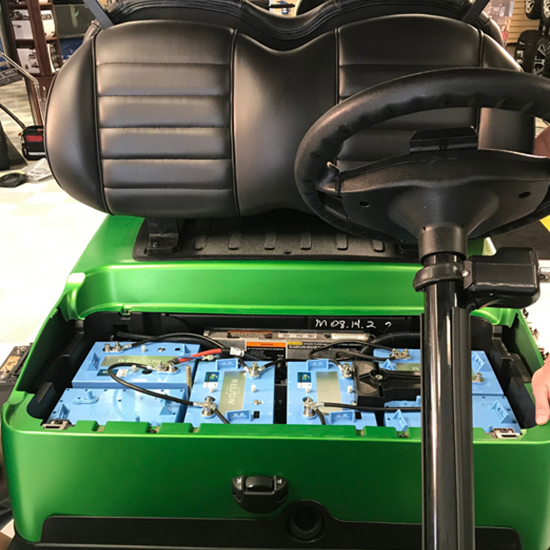
Yes, if you’ve chosen a Lithium drop-in solution that is the same GC2 size as your lead-acid batteries, you may want to consider battery spacers. Battery spacers are used to fill the empty battery slots when installing true drop-in replacement batteries, such as RELiON’s InSight 48V 30A batteries. By using battery spacers to fill the empty spots, you’re able to use the existing battery hold-down that comes in your vehicle. This makes installation easier while ensuring your batteries are properly held down. We recommend you purchase the number of battery spacers needed to properly fill all empty slots in your cart or low-speed vehicle.
If you have any questions, please contact our team of experts who are on hand to help.
Switching Lead-Acid Golf Cart Batteries to Relion InSight Series 48V Lithium Batteries
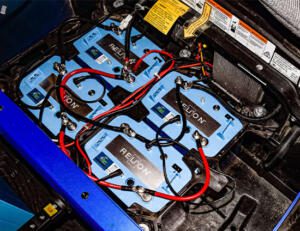
When thinking about replacing Golf Cart batteries as they begin to start failing, many golf cart owners face the same question, replace with exactly the same lead-acid batteries or consider an alternative brand lead-acid batteries. Until recently, these were the only viable options, you could call the shop you bought your cart from and have them order and replace the lead-acid batteries, you could locate a supplier of similar sized lead-acid batteries and do it yourself, or you could just buy a new golf cart. Ok, maybe that last option is a bit extreme, but some owners who do just that.
A few years ago, some of the OEM Golf Cart manufactures started selling their carts with the option of a single large Lithium battery versus the traditional four (12-volt) or six (8-volt) lead-acid batteries in 48 volt powered golf cars.
Around the same time that OEM Golf Cart manufacturers began offering Lithium batteries as an option, a few battery manufacturers started producing Lithium batteries for the replacement of lead-acid batteries in existing golf carts, this opened a new alternative to consider and the benefits that brings.
For this example we’ll take a 2017 Yamaha Drive2 PTV Golf Cart with Yamaha’s AC motor, this came with six 8-volt lead-acid batteries. After a few years of average use the batteries start to fail and the decision is made to replace them with Relion’s InSight Lithium Series batteries.
Things To Consider When Making A Decision
Lithium batteries offer several compelling advantages over lead-acid batteries, including:
- Lighter weight
- No maintenance
- Faster charge
- Retains charge for longer
- Longevity
- Direct fit, no modification
The weight savings of Lithium over wet lead-acid batteries is one of the biggest advantages, a normal set of lead-acid batteries tips the scales at 172 Kg’s. Lithium batteries pack more power than lead-acid, and in the case of InSight batteries, each battery supplies 48 volts and 30-amp hours. You can comfortably replace the six lead-acid batteries in your cart with just two Lithium batteries, and if you go with two Lithium InSight batteries, your total weight will be 32 Kg’s or a saving of 140 Kg’s! Even if you go with four Lithium batteries as we have done due to the considerable elevation changes on the courses it will be used on, your new total weight will be 64 Kg’s or a savings of 108 Kg’s!
This weight savings is immediately noticeable in your cart’s moving from a full stop, in its steering and handling. Hauling a minimum of 108 Kg’s less each time you drive your cart will mean components like brakes, suspension and tyres will last longer.
Another advantage of Lithium batteries is that there is zero maintenance, you never have to check or add water for the life of the battery.
Because of the chemistry, the Lithium batteries charge much faster than lead-acid, typically coming up to full charge after a round in just a few hours. Also, unlike lead-acid batteries that lose their capacity quickly over time (when not left on a charger/maintainer), Lithium batteries will still have 80% of their capacity after 60 days and will take two years to drop to 20% of their capacity.
Lead-acid Golf Cart batteries normally last between three and five years and usually have a 12-to-18-month warranty. Lithium batteries are rated to last eight to ten or more years, and the RELiON InSight Lithium batteries are rated for greater than 6,000 cycles @ 80% depth of discharge.
A consideration, especially for the DIY Golf Cart owner, is how difficult will the conversion be from wet lead-acid to Lithium batteries. As it turns out, not difficult at all since the RELiON InSight batteries are a direct size replacement for the OEM lead-acid batteries, more on that shortly.
With the advantages being so impressive, why wouldn’t everyone replace their lead-acid batteries with Lithium when it is time? There are a couple of reasons, many Golf Cart shops are still unfamiliar with and have no experience with, Lithium options for replacements. Similarly, since it is a relatively new technology, few Golf Cart owners have heard of Lithium aftermarket batteries and therefore do not consider them when their batteries die, but the biggest reason is the initial cost.
If you are in the market for a new Golf Cart, possibly your dealer has offered a Lithium version as an option. Currently, the Lithium option adds between £2000-£3500 to the regular cart price over traditional lead-acid batteries. Returning to the focus here, replacing original lead-acid batteries in the golf cart you already own, a set of six good lead-acid batteries will cost about £1300 plus installation plus another £50 to £100 for a battery fill kit if you want/need one.
Depending on how you use your golf cart, and how hilly your golf course is, you can choose to replace the six eight-volt batteries (48-volt system) with either two, three or four 48-volt Lithium batteries. A major difference between the lead-acid batteries in a golf cart and Lithium, is that Lithium is scalable, that is, you can start with a two Lithium battery system, and if you find you need more range, you can simply add one or two more Lithium batteries to your system later on.
Two InSight batteries will provide 60 amp hours and 24-34 miles per charge, three will provide 90 amp hours and 36-50 miles per charge and four will go 48-70 miles per charge with 120 amp hours. The current price for the RELiON InSight Lithium 48-volt batteries is two for £3520, three for £5280, and four for £7040.
Why RELiON over other Lithium options? Whilst there are other Lithium batteries out there, Relion’s quality make them a standout performer in Lithium Golf Cart batteries.
Unlike some competitors, RELiON did not modify existing Lithium batteries and components to work in a golf cart environment, rather they designed the InSight from a clean sheet approach. In essence, they laid out everything they wanted a Lithium battery to be able to do in a golf cart and golf cart environment and then designed the battery to do that. I encourage you to check out the details of the construction, impressive ‘unique SuperSmart BMS’ (battery management system) that is incorporated into each battery, in our Relion Videos section.
Installation
We have four RELiON InSight Lithium 48-volt batteries along with the charger unit ready to be installed.
The first step is to remove the six 8-volt Trojan T-875 lead-acid batteries from the cart, to facilitate this, remove the seat and switch the “Tow/Run” switch to tow to ensure that the cart motor and electronics were not inadvertently damaged by the removal and installation of the batteries.
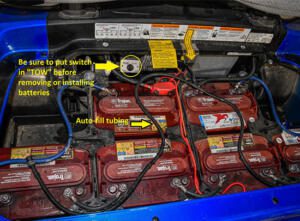
The cart had an auto-fill system attached to each of the Trojan batteries (this system makes it easier to maintain the correct fill level when adding distilled water for required battery maintenance). Once the hose connections are removed duct tape was placed across the fill hole in each battery to ensure no acid was spilled when the battery was removed.
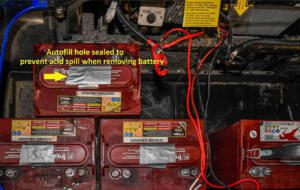
Next, we used a 14mm socket to remove the nuts securing the battery cables (careful to not short across the terminals with your wrench). You can save and reuse the original cables; we’ll discuss this shortly. Follow by removing the nuts on the battery retainer brackets, these required a 12mm socket.
The batteries are now ready to be lifted out. The easiest way to remove the batteries is with a lifting strap that hooks onto the lift tabs at top of the batteries. Take care, as the batteries each weigh about 30 Kg’s and you want to lift each one up as straight as possible to avoid spilling out any of the battery acid. You can dispose of the lead-acid batteries at Go Batteries for free, if that is not convenient, call your local recycling centre.
After you remove the batteries, take a couple of minutes to clean out the battery tray of any debris that has accumulated. Also, use some sandpaper to clean the cable ends from your cart that run from the batteries to the motor/controller and from the charging port.
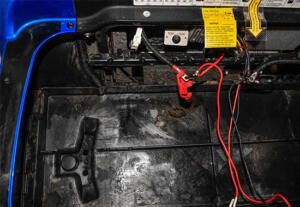
As mentioned, you can reuse some of the battery cables you removed (you won’t need all of them), but it is best to use cables of equal length for the connections between your new Lithium batteries. If your original cables are equal in length and in good condition, go ahead and use them, if not, I recommend you order new cables. You will need one pair of new cables if you go with a two-Lithium battery set up, two pairs for a three-Lithium battery set up, and three pairs for a four-Lithium battery set up as shown below. The length that you need to order will depend on how your batteries sit in your battery tray. In this case, we used three sets of one-foot-long cables with 5/16 ring terminals.
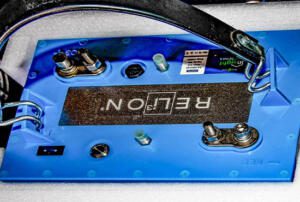
Now you are ready to install the RELiON InSight Lithium 48-volt 30-amp batteries. This process is the same, whether you decided to go with two, three or four to power your cart. Place the Lithium batteries onto the battery tray, using the positions closest to the negative and positive cables from your motor/controller. You will follow by putting in the spacer units (if you purchased these) to enable the reuse of the battery retainer brackets, finish by reattaching the battery retainer brackets.
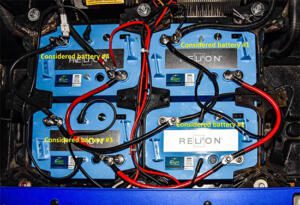
The next step is attaching the cables. Note: this is very different from how your lead-acid batteries were connected. Your Lithium batteries are connected in parallel. That means the cable from one battery’s positive terminal is connected to the next battery’s positive terminal. Similarly, the cable from one battery’s negative terminal is connected to the next battery’s negative terminal, see diagram below.
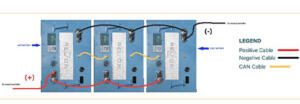
Start with your ‘first’ Lithium battery in the group, that will be the Lithium battery you are connecting the negative cable from your motor/controller (see above picture, first battery is labelled #1). On that battery, you connect the negative cable from your motor/controller and one connecting cable to the same negative post on the RELiON InSight battery. You will also connect the negative cable from your cart’s charger port here. The nut on the RELiON InSight battery post uses a 13mm socket (there is also a stud that uses an M8 Allen wrench that can be used). Tighten to 6.6 to 7.4 ft-lbs if you have a torque wrench. Otherwise, tighten firmly but do not over tighten. Now connect the other end of the cable attached to the first battery negative terminal to the next battery’s negative terminal. Continue connecting each of your battery negative terminals the same way.
Going back to the ‘first’ Lithium battery, now connect its positive terminal to the second battery, again using either the 13mm nut or M8 stud. Continue to your last battery. Now connect the positive cable from your motor/controller to the last battery’s positive terminal. Also, connect the positive cable from your cart’s charger port here.
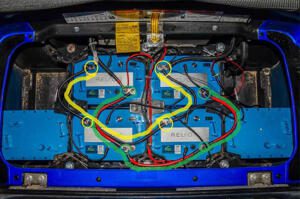
Recheck all of your cable connections. The first battery should have the negative cable from your motor/controller and be connected to the second battery negative terminal. The first battery does NOT connect to your motor/controller positive cable. Its positive terminal only connects to the second battery positive terminal. The last battery in your system should have the positive cable from the motor/controller connected to its positive terminal, as well as be connected to the positive terminal on the next battery in the parallel setup. The last battery does NOT have a connection from its negative terminal to the motor/controller negative cable. You can see this in the following image.
When you opened the boxes with your new RELiON InSight batteries, on top was a CAN cable for interconnecting the batteries. This cable is used to enhance charge and discharge balancing between batteries.
With all of the battery cables now in place, it’s time to connect the CAN cables. Before you connect them, take a close look at the end of one of the CAN cables as well as the CANbus ports on top of a battery. You’ll see that the female connector on the CAN cable has an angled section that must be aligned with the same section on the CANbus port on the battery per the following images.
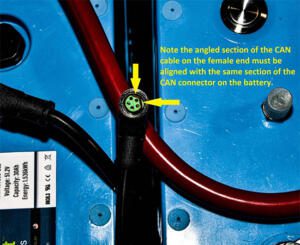
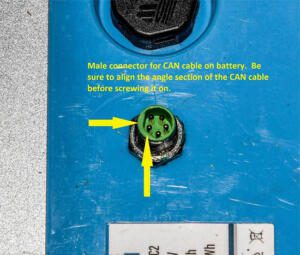
Now, begin with the ‘first’ battery (the one connected to the golf cart negative motor/controller cable). Connect the CAN cable to the Output CAN port, ensuring that you have its angled sections aligned. It is the one on the positive side of the battery (#3 in the below battery top guide image). Take the other end of this CAN cable and connect it to the Input CAN port (the negative battery side, #2 in the below battery top guide image) of the second battery. Continue connecting the remaining CAN cables the same way for the rest of your batteries.
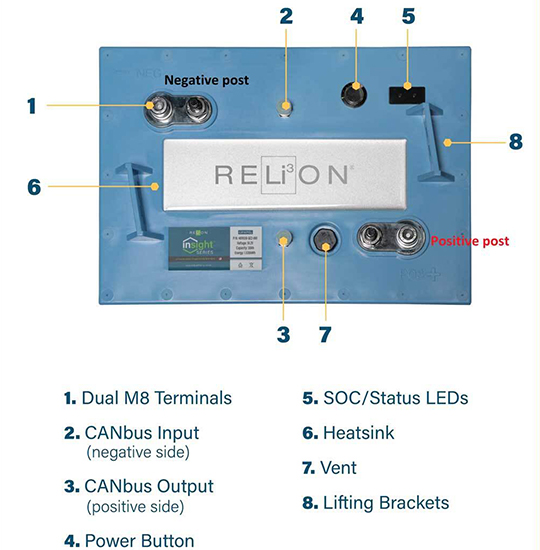
Relion InSight 48V 30A Battery Top guide.
When you are done, recheck all of your CAN cable connections. Your first battery should only have one CAN cable connected (at the Output port) and the Input port remains unused at this point. Similarly, the last battery should only have one CAN cable connected (at the Input port), and the Output port remains unused at this time.
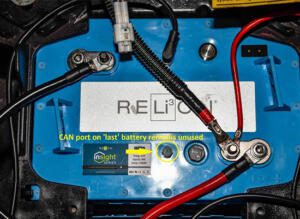
The final connection step is optional. If you ordered the InSight Series™ Fuel Gauge, you would need to connect it at this point.
The fuel or battery gauge is not required but is very useful extra feature to know the state of charge of your batteries. RELiON InSight batteries has a state of charge set of LEDs on the top of the battery, that function to tell you the remaining charge, ranging from 0 to 100%, however to see this, you would need to lift your cart seat in order to get this information. Using the InSight gauge is a much easier option and can be used as a direct replacement for your cart’s original battery gauge, or as an additional gauge to your original one, but the odds are that your original gauge will not correctly tell you the state of charge because it is normally designed to measure voltage, rather than current. The InSight gauge provides you two continuous readouts, one displaying the % of charge remaining and the number of amp-hours remaining, the second display shows also the % of charge remaining along with the number of Lithium batteries connected.
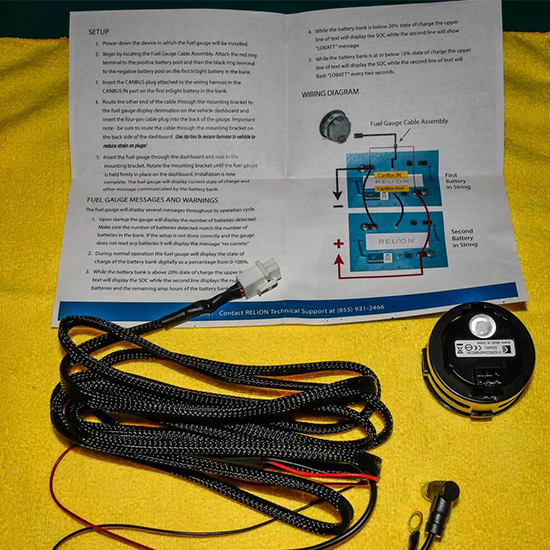
Connecting the InSight series gauge is very simple. At the end of the wiring harness supplied with the gauge, you’ll find a red wire with a ring terminal, a black wire with a ring terminal, and a CAN connector. Go to your ‘first’ battery, connect the red ring terminal to the positive pole, the black ring terminal to the negative pole, and the CAN connector to the unused CANbus Input port.
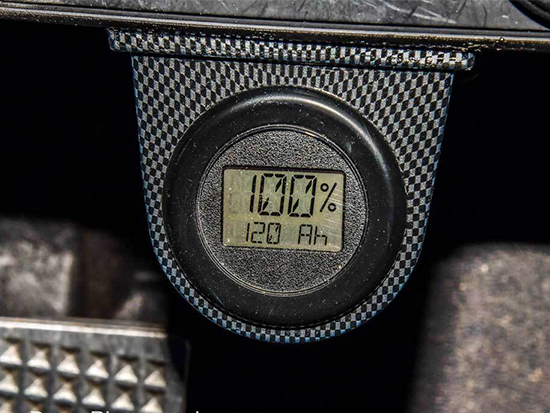
Now route the gauge harness up to the place where you are mounting the meter, using zip ties to secure the harness to the the cart frame. You can simply replace your cart’s existing meter if it is a standard round gauge or mount the InSight meter separately.
Ready To Go
The first time you power on your new RELiON InSight batteries you simply press and hold the Power button (see #4 in the Relion Battery Top guide image above) on the first battery until you see the first LED flash green. It will then continue to flash green every five seconds. Shortly thereafter, you will see the remaining batteries come to life; their respective first LED will similarly flash green.
Once all the batteries are ‘awake’ you can press and release the power button once on each battery, and then the two LED’s will tell you the state of charge. You are now ready to go! Along with the satisfaction of having done this conversion be prepared for the very noticeable difference and feel of the quick acceleration and easier steering/handling of your golf cart.
After you have taken it out for its maiden run, plug your charger in and give the batteries a full charge.

















